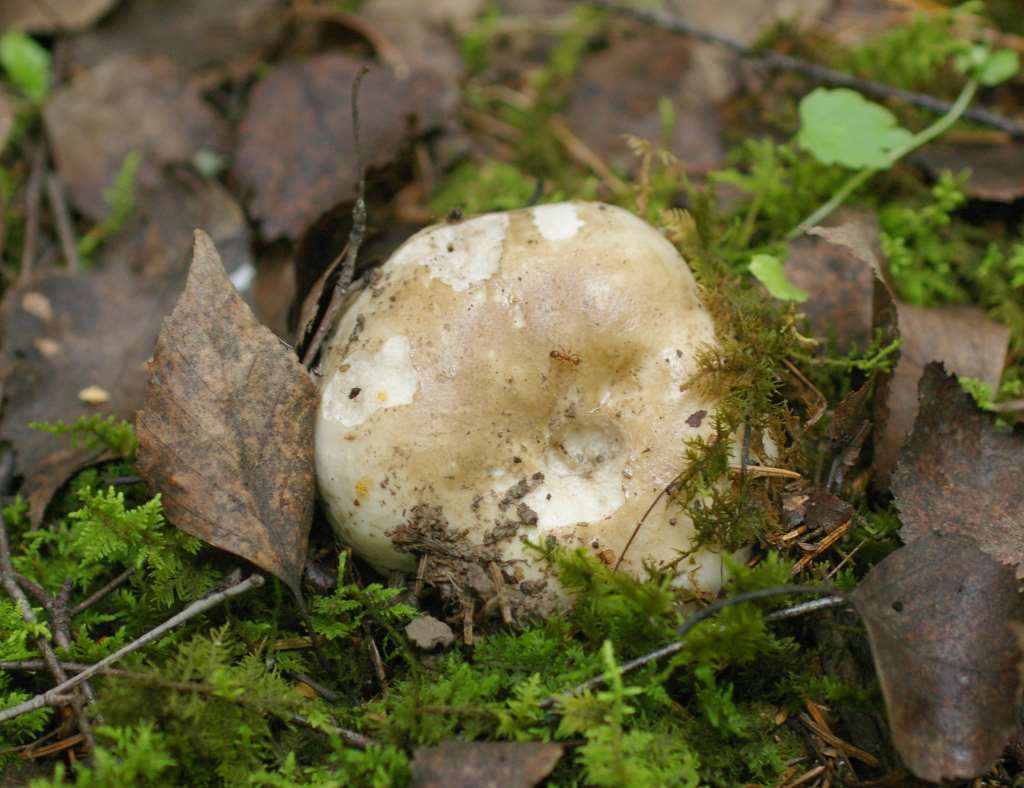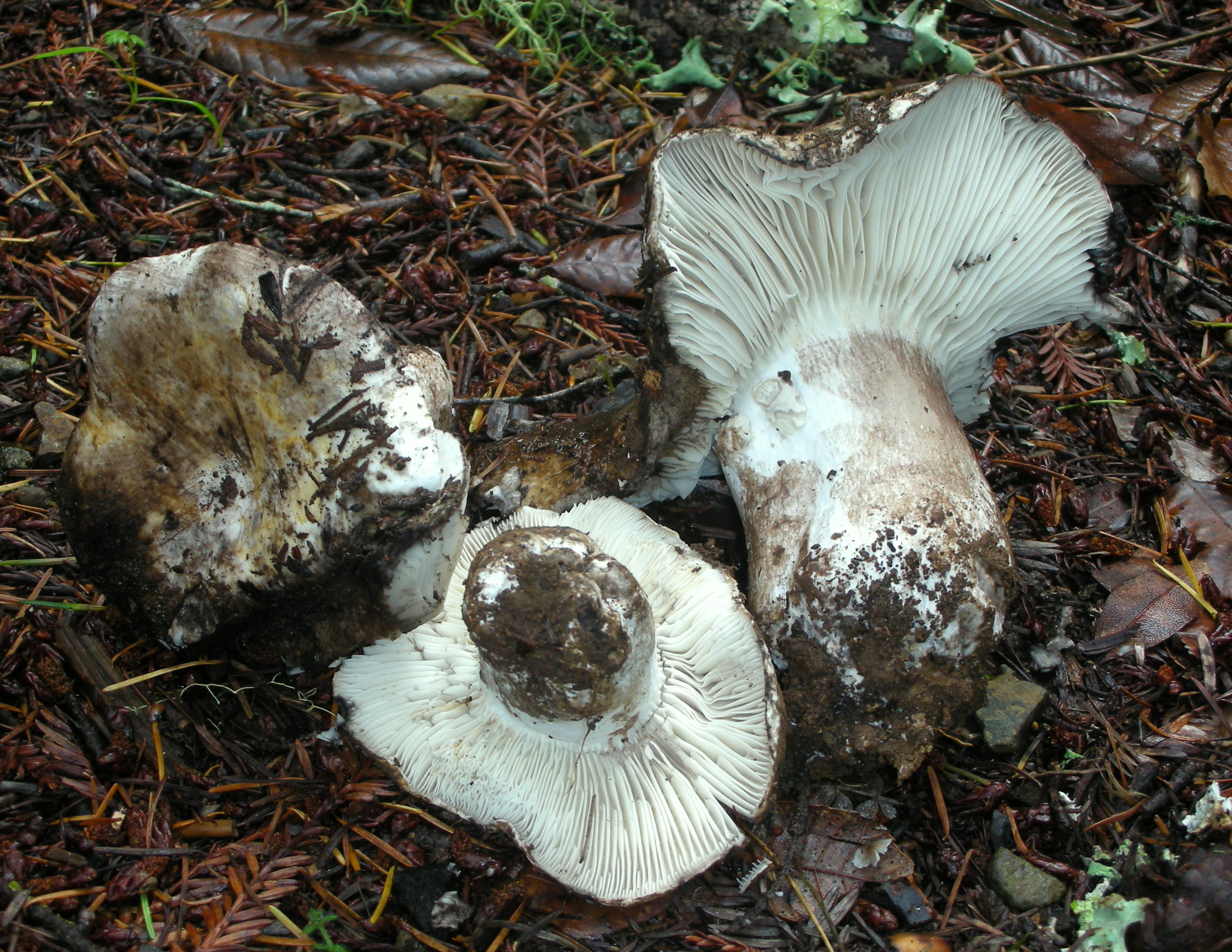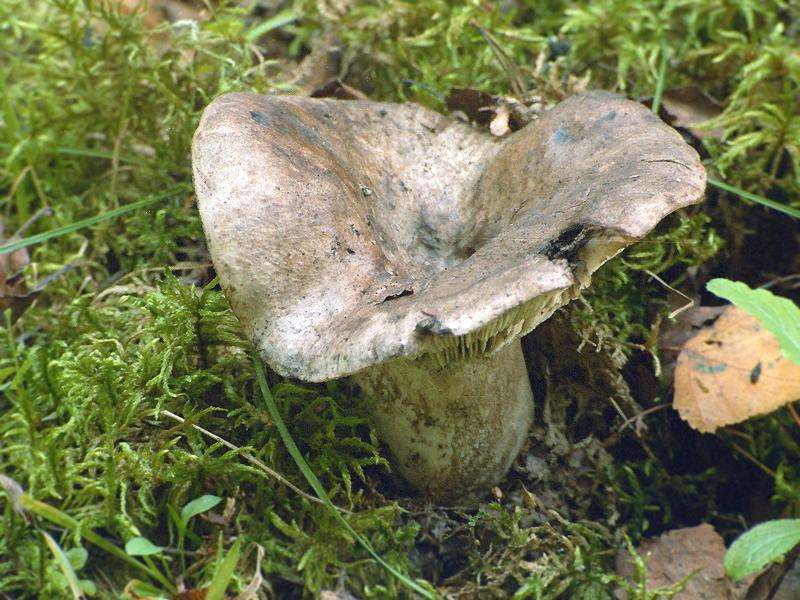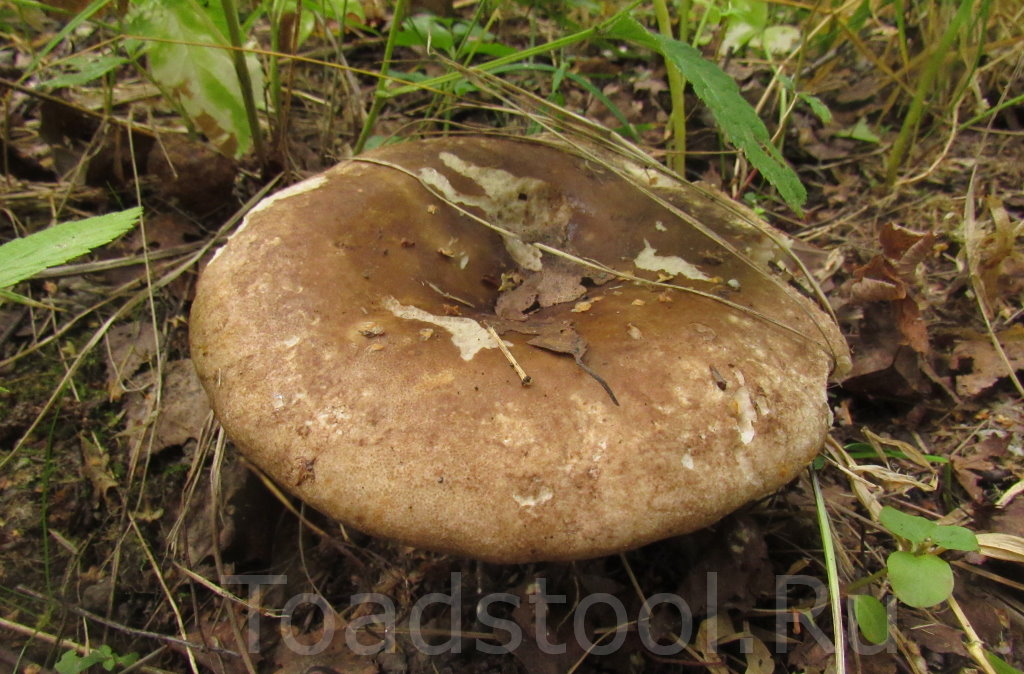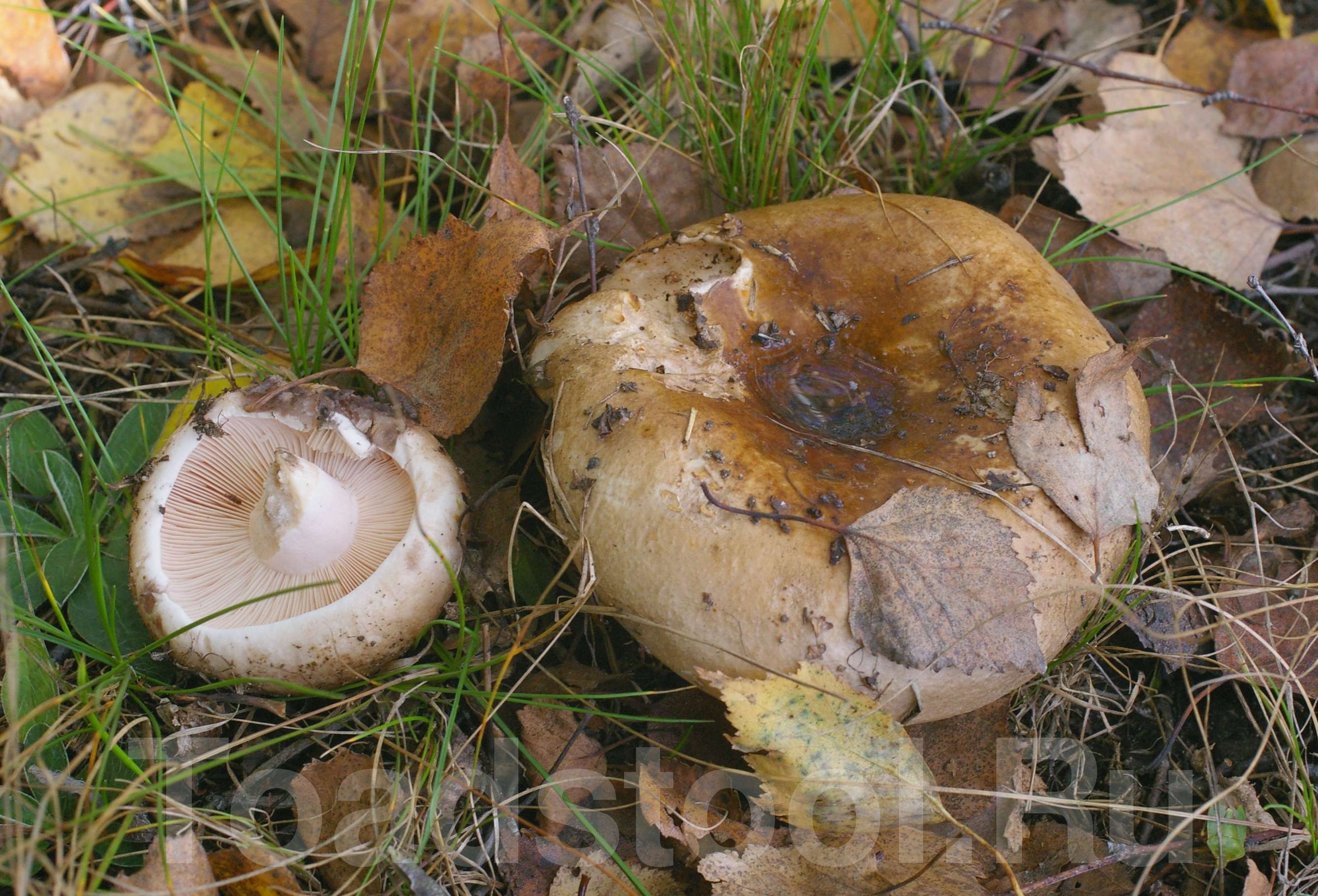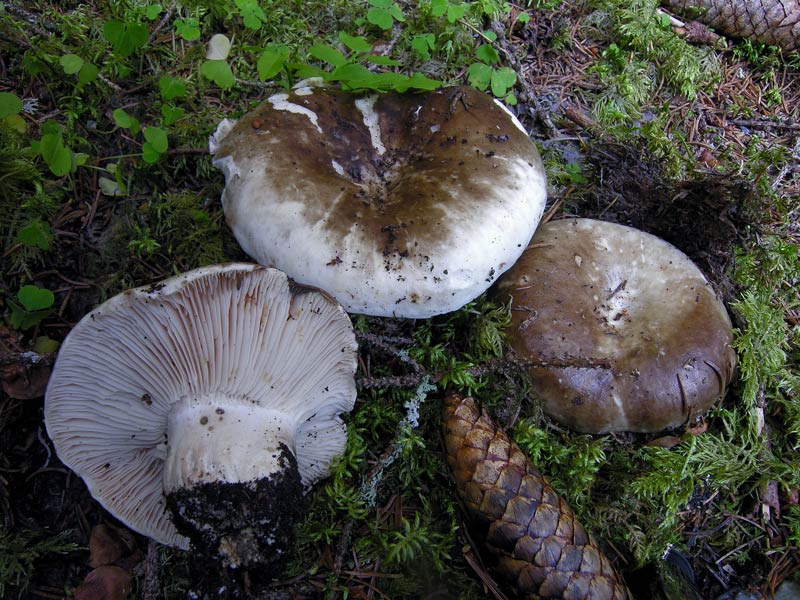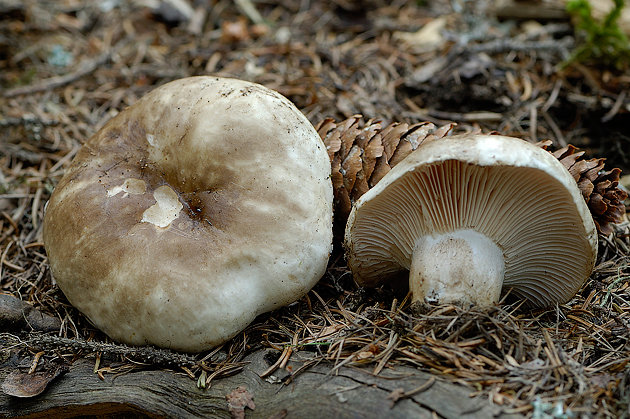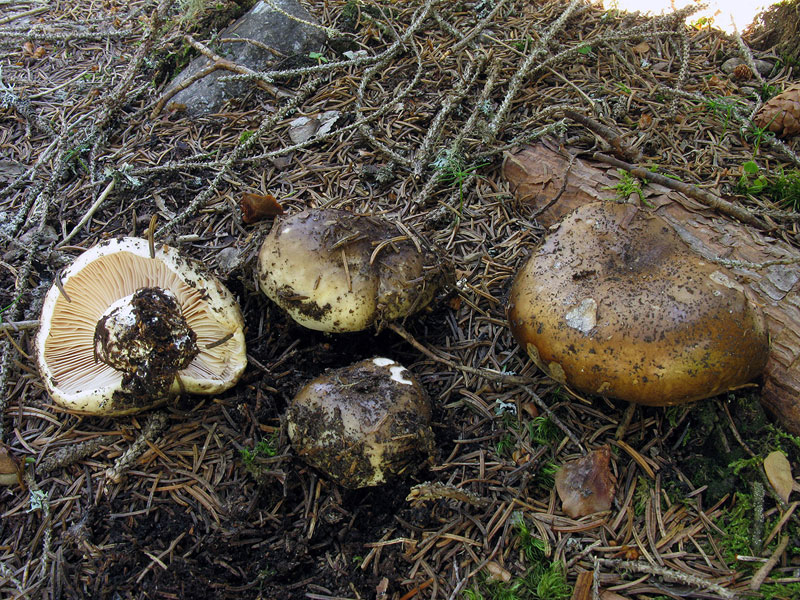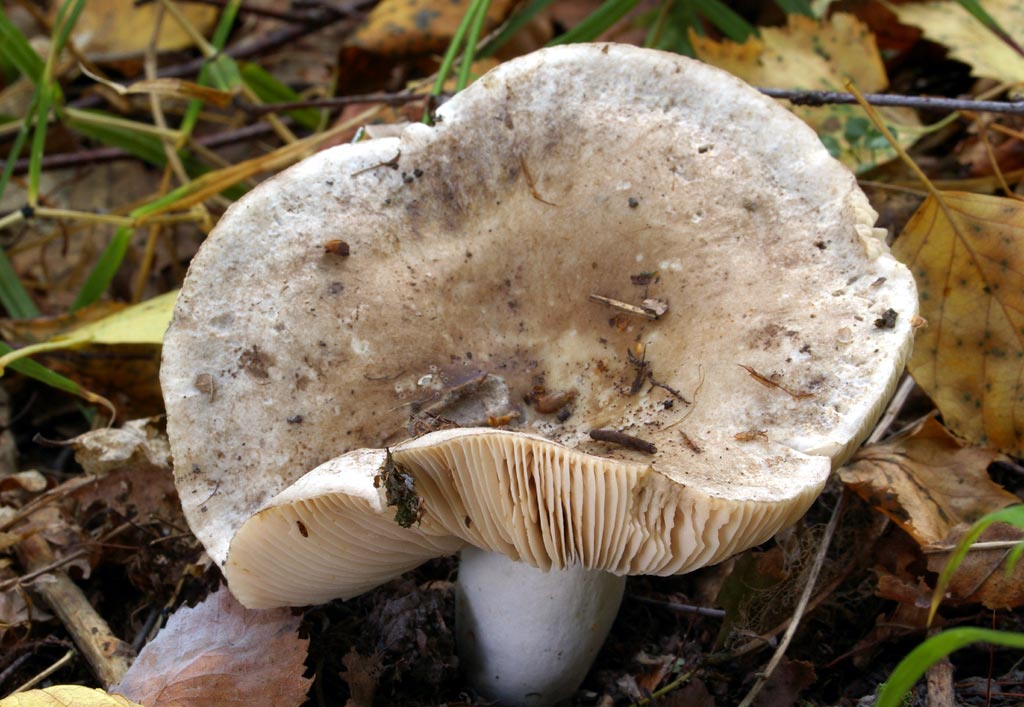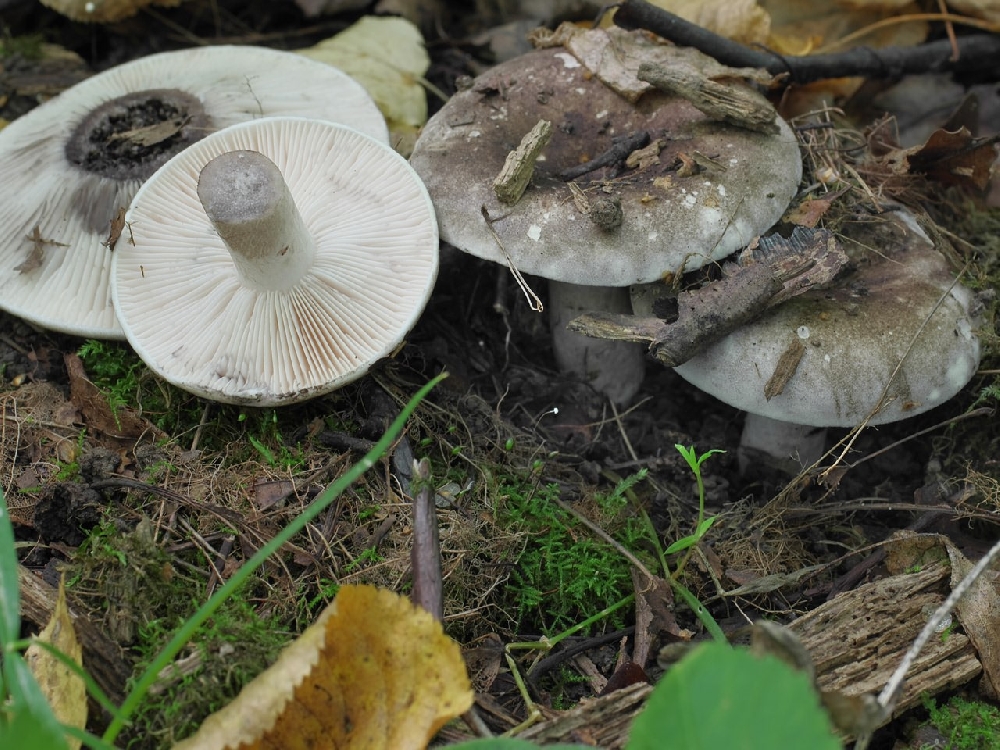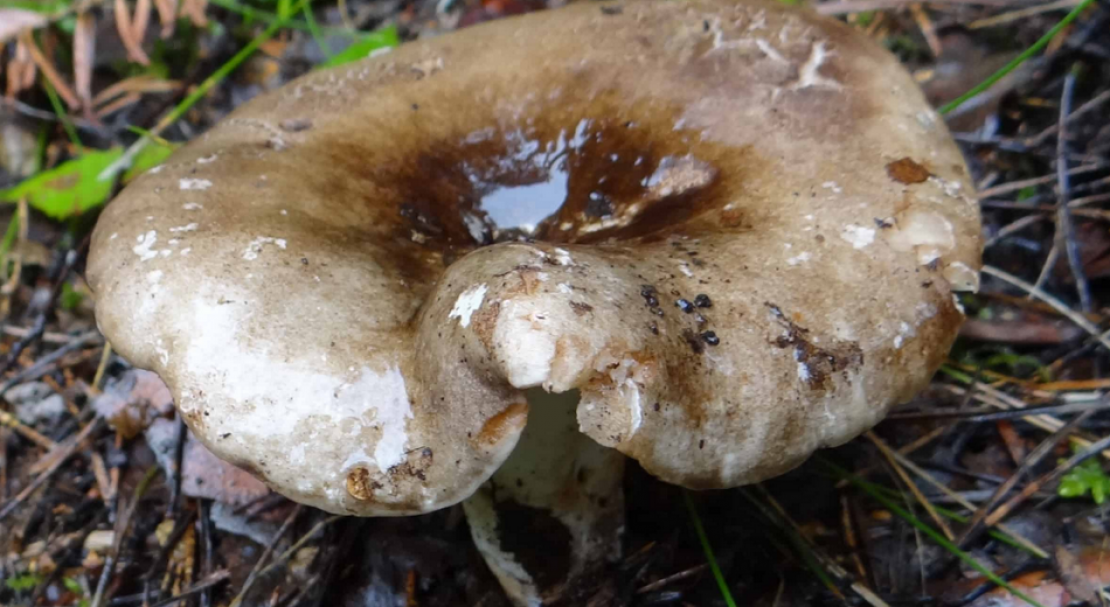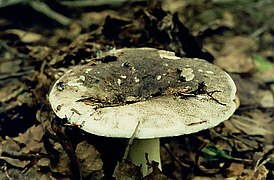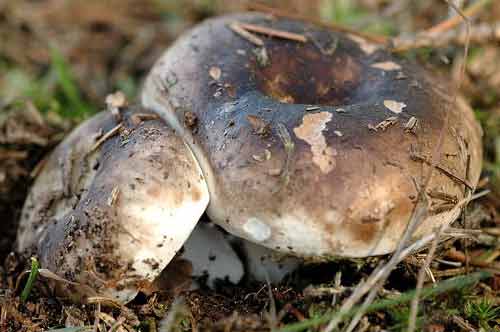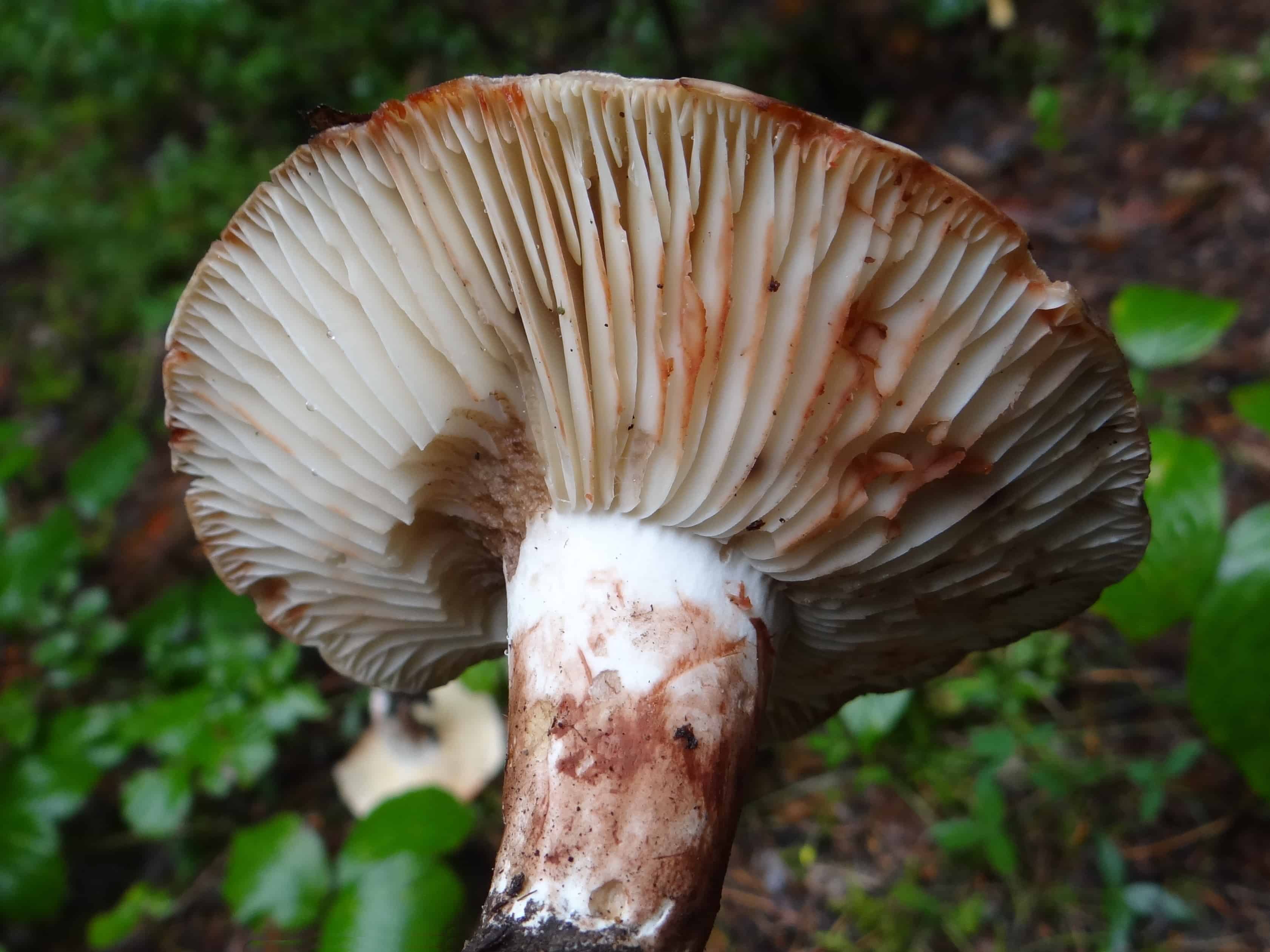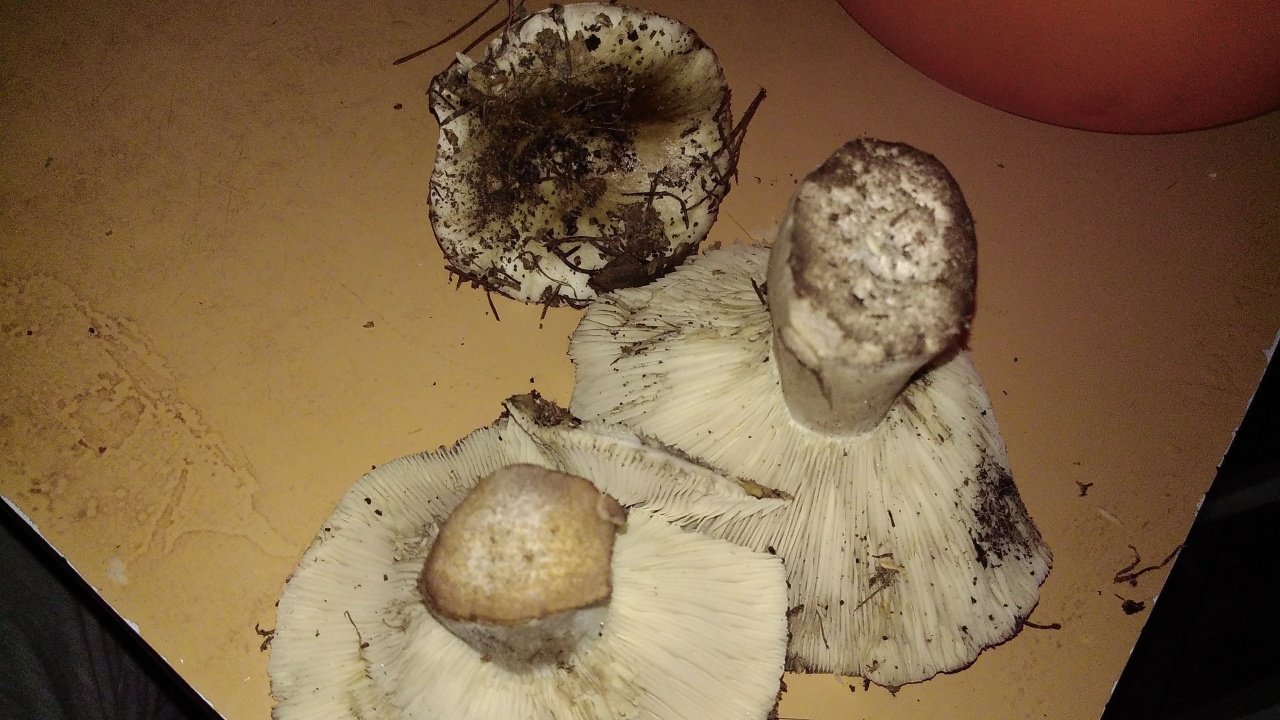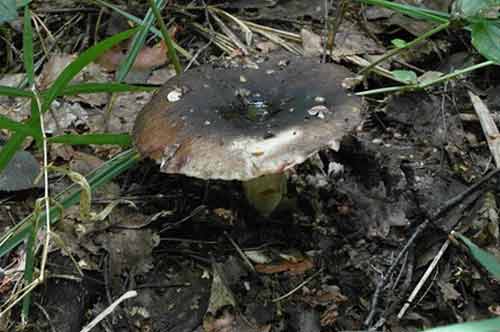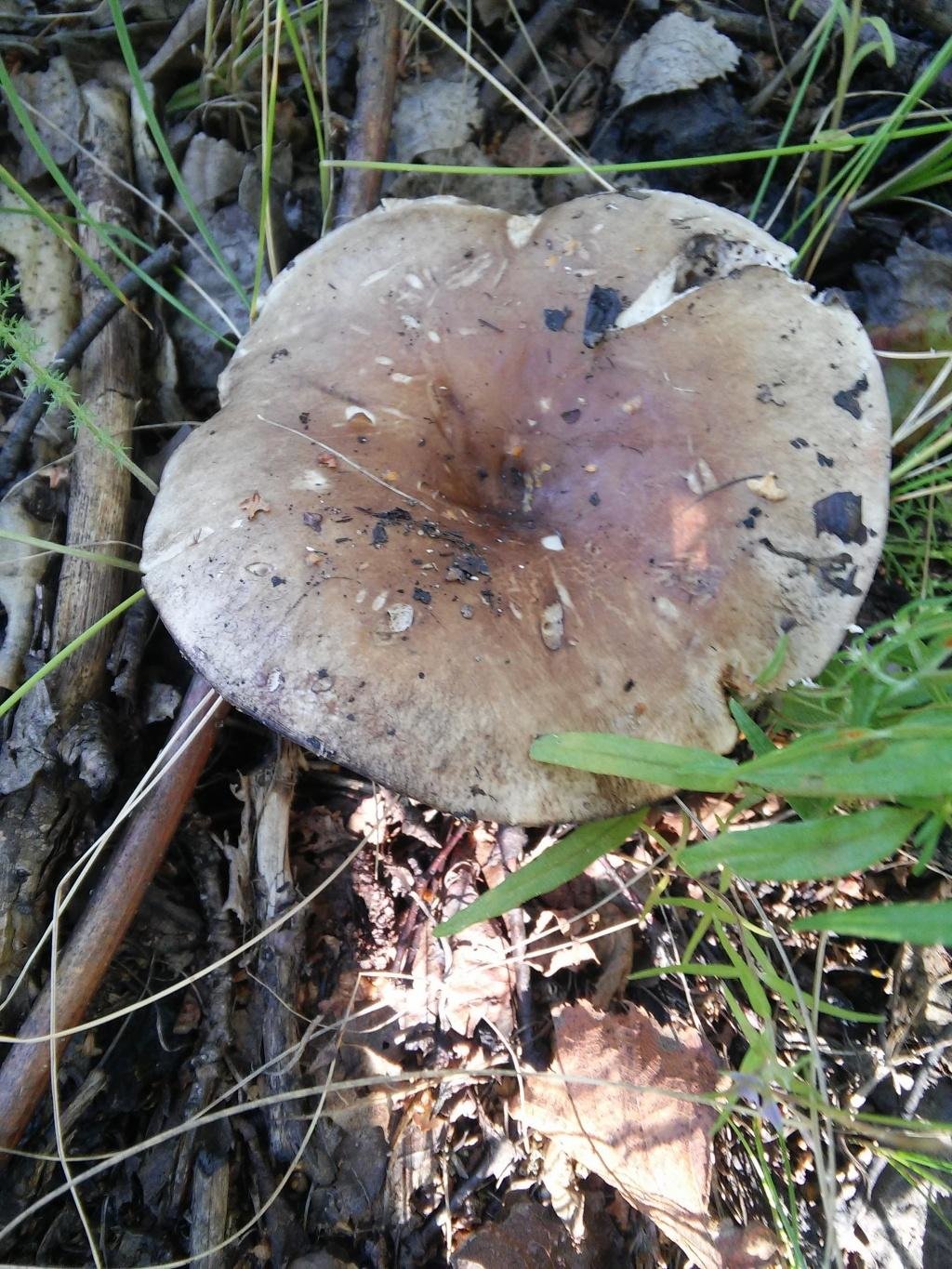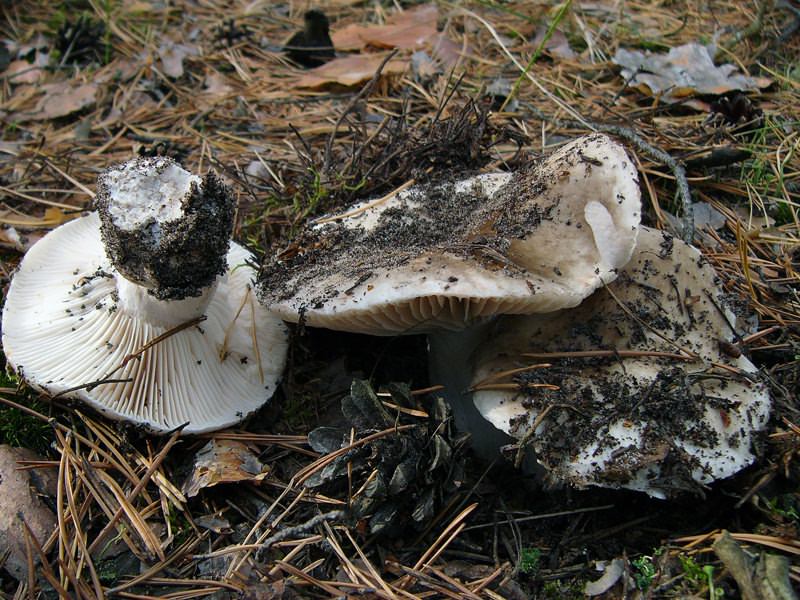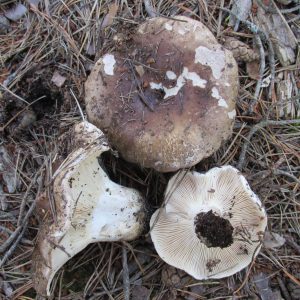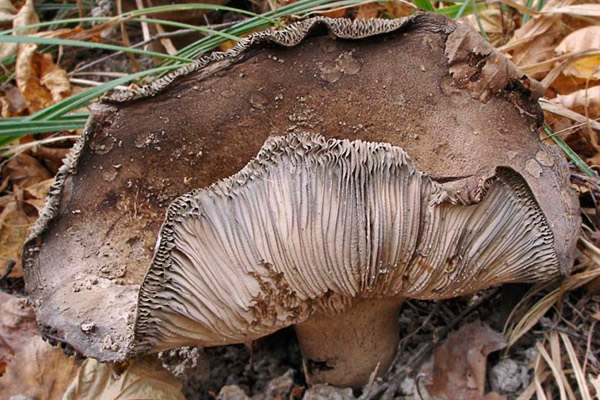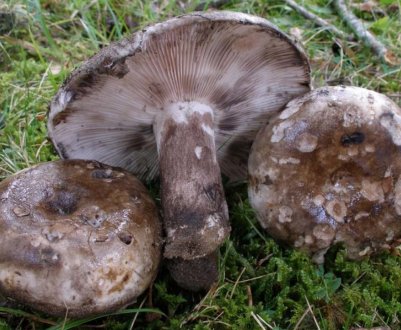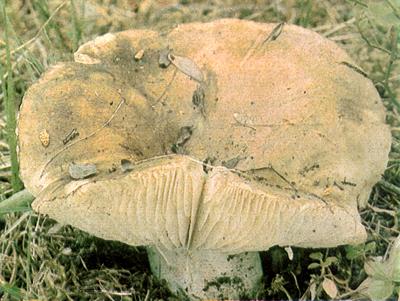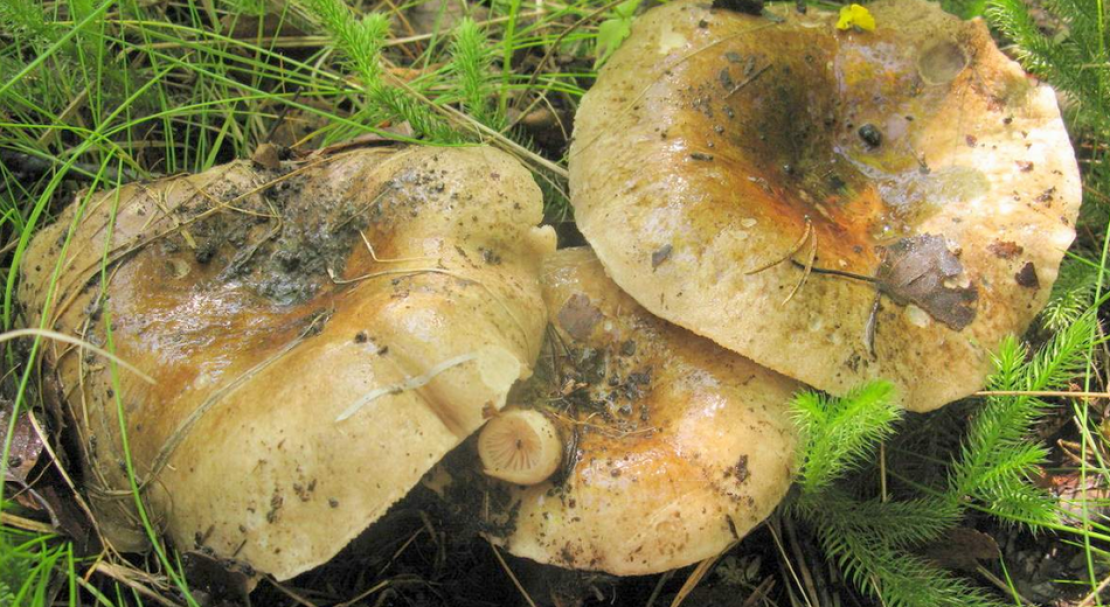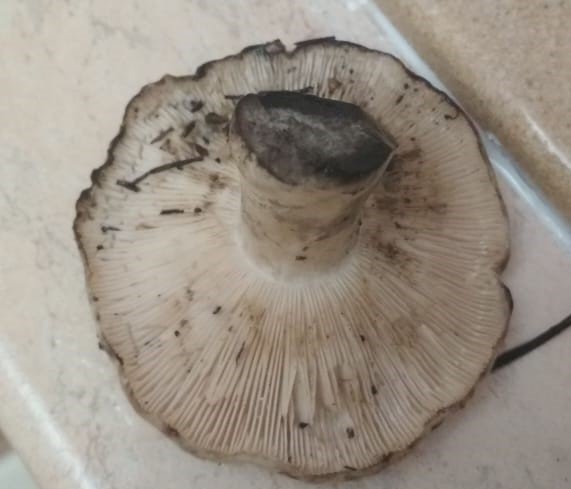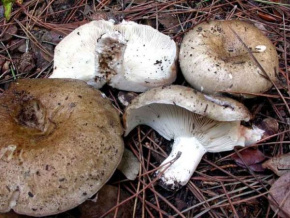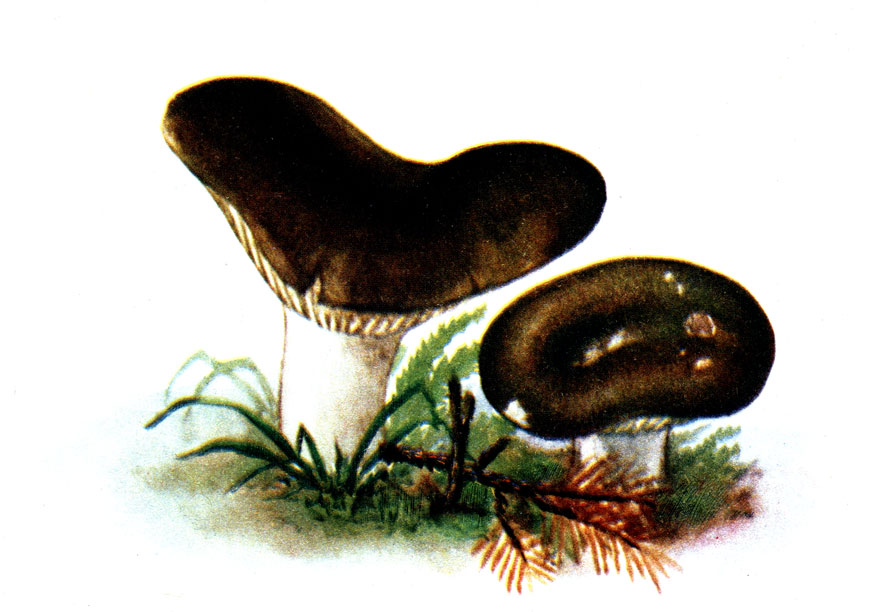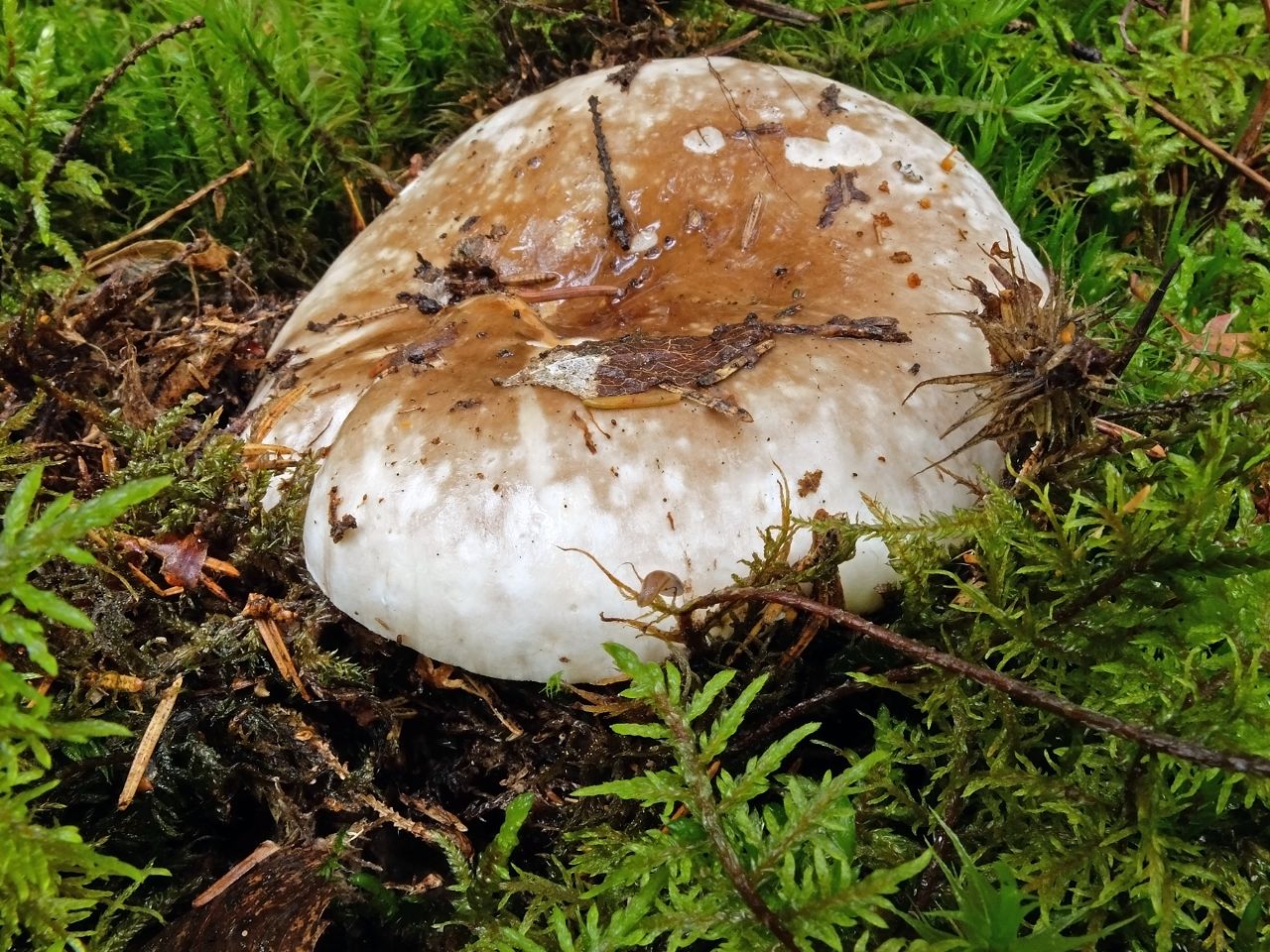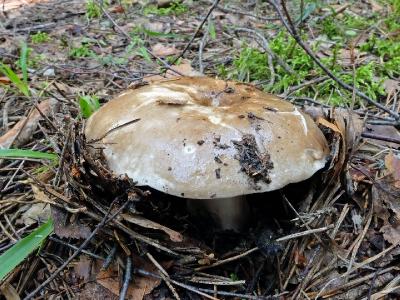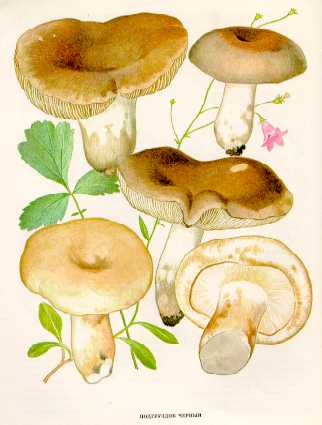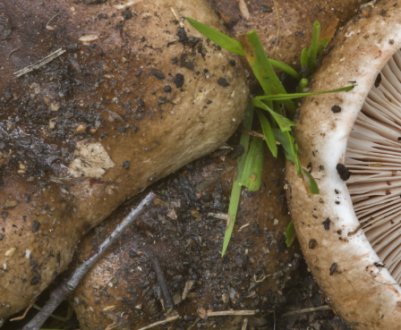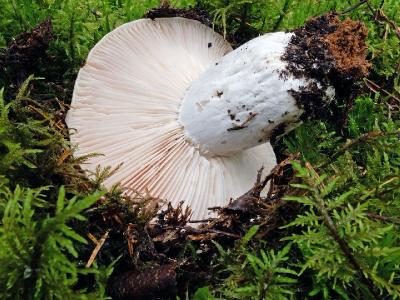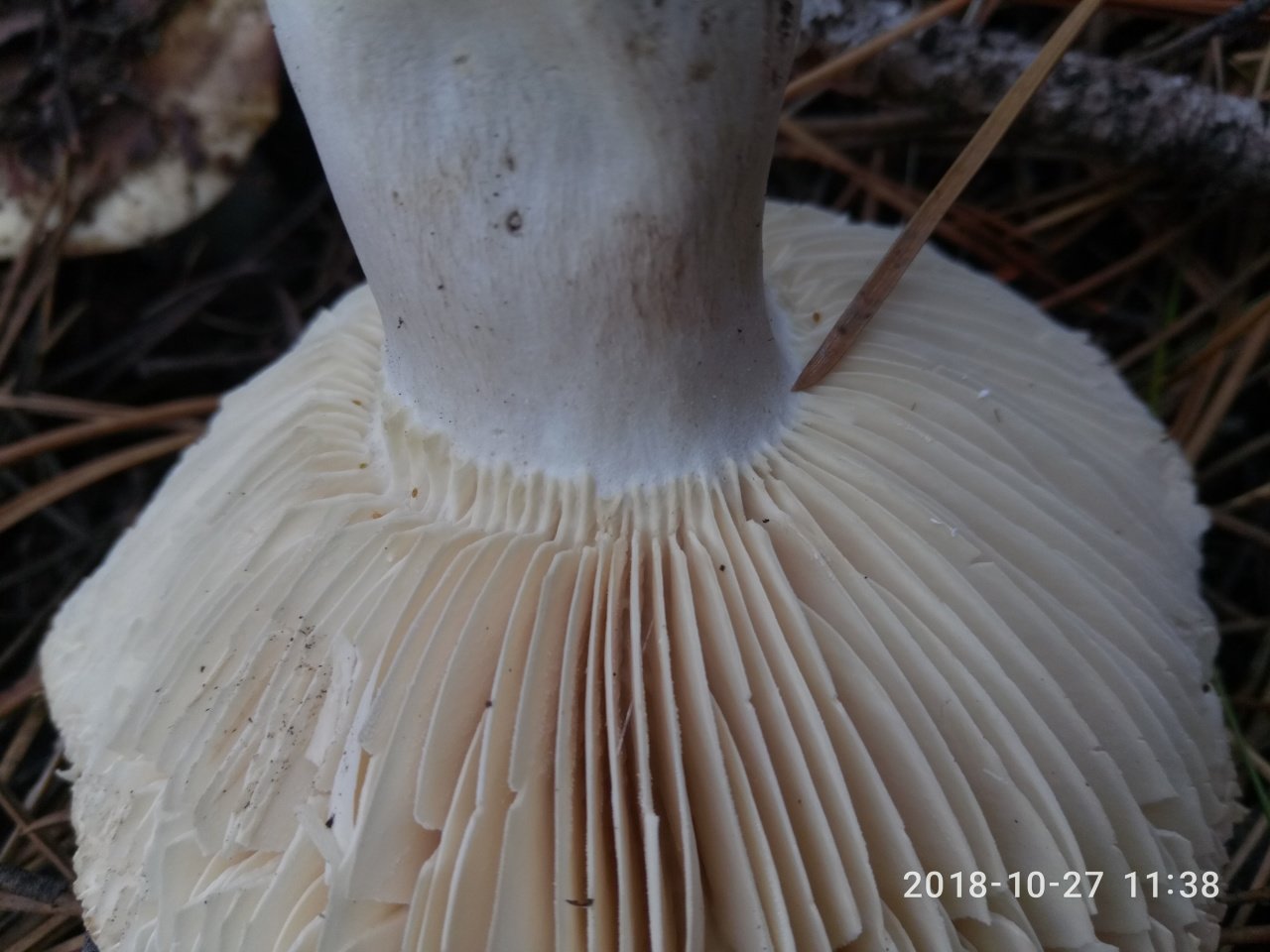Gifts of nature - articles: black podgruzdok
Insert-mushroom-tree synonyms Omphalia adusta (Pers.) Gray 1821
Russula nigricans var. adusta (Pers.) Barbier 1907
Agaricus adustus Pers. 1801
Russula adusta f. gigantea Britzelm. 1895
Russula subusta Burl. 1915
Etymolgia: Russula (russula) adusta (lat.adustus - scorched, charred).
The cap is 5-10 (15) cm in diameter, densely fleshy, semicircular, flat-spread, depressed in the center, as a rule, with a drooping sharp, smooth edge. The skin is adherent, slimy, naked, in dry weather shiny, umber, dirty brown-black, often with an olive tint, dark gray-brown in the center, lighter towards the edge.
Plates: adherent toothed, frequent, narrow, white, turning yellow with age and then acquiring the color of the cap, with darker brown spots.
Leg (2) 3-5 (7) x 2-3 (5) cm, cylindrical, made, firm, naked, smooth, whitish, then one tone lighter than the cap.
The pulp is dense, white, slightly pink in the air, then blackening, the taste is fresh or slightly sharp. Under the influence of FeS04, it turns pink, then turns green. The taste of the plates is soft.
Spores: from ellipsoidal to rounded, (7) 7.5-9 (10) x (6) 5-7 (8) microns, warty-fine mesh ornamentation.
Spore powder: pure white.
Basidia: 40-65 x 8-10 microns. Cystids 50-80 x 5-7 microns, cylindrical, not frequent, from sulfovanilin stained blue. The cuticle of the cap is gelatinous, consists of hairs and rare dermatocystids, which are separated at the apex.
The habitat grows in mixed and coniferous forests, in groups, often.
Season: June - September.
Distribution in Kazakhstan: quite common in the northern part of the country.
Habitat: Europe, Asia, North. America, Australia.
Edible: The mushroom is edible, but usually only used for pickling after boiling.
Russula adusta, podgruzdok black
Hat:
Diameter 7-15 cm, first flat-convex, then flat-concave, at first white-grayish, then unevenly colored, dark olive-brown, black. The pulp is grayish, thick, brittle, at the break it first turns red, then turns gray. The taste is sweetish.
Hymenophore:
The plates are at first white, subsequently grayish, darken when pressed, adherent.
Spore powder:
White.
Leg:
Relatively short and thick, 3-7 cm in length, up to 3 cm in thickness, cylindrical, solid, of the same color with a cap or lighter, often with dark spots, darkens when pressed.
Similar species:
There are enough similar mushrooms with gray caps and blackening pulp in the genus of russula. The differences are pretty minor. For example, blackening load, Russula nigricans
- the pulp, upon contact with air, undergoes the same metamorphoses (from pink to dark gray), but rare plates. Russula albonigra
blackens radically, without any flirting with the red part of the spectrum. Have R. acrifolia
distinctly bitter flesh. And so on. All this deserves a detailed analysis, which will, without any doubt, be made from a historical perspective.
Edibility:
It is considered a good edible mushroom. Doesn't require any special measures.
Author's notes:
As you surely already know, Russula adusta
- the record holder for attendance by worms. In our area, it is often found, especially at the beginning of the fruiting period, from mid-July to mid-August, but I can say without exaggeration: I still do not know what it tastes like. Once I found two (!) Completely non-wormy mushrooms in a very raw, dark and completely non-mushroom broadleaf in the Tula region, but it so happened that already at the stage of preparation, these specimens were mixed with the rest of the mushrooms, and I could not figure out what this is what the larvae of mushroom flies find in this wonderful mushroom.
Black podgruzdok differs from other blackening russules with difficulty. The frequency of the plates is one of the signs that make it possible to persuade the mushroom to the species Russula adusta. One, but not the only one.
The mushroom, by the will of fate, has spent most of its life under a thick layer of litter, crawls out like this. And it's good if it comes out - a significant part of the black pods will never see the light of day. However, why light - mushroom flies still fly to smell
Other names
: nigella, black russula
Usually grows in the northern half of the forest zone in coniferous and deciduous forests, sometimes in large groups, in July - October.
Hat
up to 15 cm in diameter, at first flat-convex, depressed in the middle, with curved edges, later, with the growth of the fungus, it becomes funnel-shaped. not pubescent, slightly sticky, in young mushrooms with a dirty-grayish color, then olive-brownish, and in old ones - dark brown.
LPs
frequent, narrow, whitish or grayish, often with dark spots, somewhat bitter in taste.
Leg
short, thick, dense, cylindrical, even, smooth, monochromatic with a cap or lighter, darkens when touched.
Pulp
rather brittle, white or brownish-gray, without milky juice, unlike the plates, not spicy.
Controversy
rounded, mostly white.
Conditionally edible mushroom
... Usually used for salting after pre-boiling or soaking. It differs from black milk in the absence of milky juice.
It has no resemblance to poisonous mushrooms.
Russula blackening
The cap is 8-10 (20) cm in diameter, densely fleshy, convex, then flat-spread, slightly depressed, with a sharp, smooth edge. The peel is adherent, at first sticky, then dry, naked, smooth, in a dry state matte, grayish-brown, almost black. The plates are attached, rare, thick, wide, forked, with plates and anastomoses, white, cream, blackening with age. The leg is 2-6 x 1-3 cm, cylindrical, at first hard, then brittle, made or with cavities, naked, smooth or finely felt, colored to a tone lighter than the cap. The pulp is fragile, loose, white, reddening in the air and then blackening, the taste is fresh, soft, without a special smell. When exposed to FeSO4, it turns dark green. Spore powder is white.
Habitat - deciduous, coniferous and mixed forests. It occurs from July to October. Grows in groups.
The cap is up to 15 cm in diameter, at first convex, in a mature mushroom it is depressed, with curved edges, dirty gray, then brown or black, sticky. The pulp is white, brittle, without milky juice, turns red at a break or cut, then turns brown and finally turns black. The taste is sweetish.
The plates are adherent to the pedicle or descending, white, darken from pressure. Spore powder is white.
The leg is up to 5 cm long, 2.5-3 cm thick, even, dense, of the same color as the cap.
Little known edible of the third category. It is consumed boiled and salted. When salted, it turns black. It is very badly damaged by insects.
And blackening: description of the mushroom and what the milk mushroom looks like in the photo
Active growth requires a lot of light and little heat. This mushroom grows in huge quantities in deciduous and mixed forests of the middle zone of our country. Usually, its mycelium dislocations are located near aspens and birches. It is these trees that create the most favorable conditions for their existence.
Podgruzdok popularly has a simpler name. This is a dry lump. It is not by chance that the mushroom is called that. Unlike ordinary ones, they are never covered with mucus and do not get wet. The surface of their caps is always dry and slightly rough to the touch.
A regular load looks like this. This is a fairly strong cap with edges bent inward and up to 20 cm in diameter. The upper surface of the cap is matte white with yellowish blotches. During the growth process, the fungus is prone to cracking. A characteristic feature is the absence of milky juice on the cut of the stem and cap. Podgruzdok or dry lump belongs to the second category of edibility. It can be used for salting without pre-soaking in water
Podgruzdod black or black
From the beginning of July to the very end of October, the coniferous and deciduous forests of our country can delight you with a rich harvest of another type of dry milk mushroom. This is a black load. It is also called black russula. And this is no coincidence. Outwardly, the black podgruzdok really resembles a russula.The hat is up to 15 cm in diameter and has a glossy dark blue, almost black surface. There is no milky juice.
Black podgruzdok can be eaten boiled, fried and salted. Does not require soaking by direct use.
Podgruzdok porcini and mushroom rusk
Podgruzdok porcini and mushroom rusk are the names of the same specimen. This is a variety of mushrooms and lamellar mushrooms, which are abundant in bright places in deciduous forests. They can be eaten without boiling or steeping. They are distinguished by the absence of bitterness and unpleasant taste. belong to the category of little-known. But don't neglect them. They contain a fairly large amount of protein and various active substances that improve digestion. Dry mushrooms make an excellent mushroom powder for sauces and seasonings.
What does a blackening load look like
Blackening podgruzdok is another type of lamellar mushrooms that are found by mushroom pickers in mixed and deciduous forests and at the same time go unnoticed. Many confuse them with poisonous and inedible due to their unsightly appearance. But let's try to figure it out.
There is a certain opinion among mushroom pickers that the lamellar must necessarily produce milky juice. Dry milk has no milky juice. And this does not mean that it is poisonous. The blackening podgruzdok in appearance resembles a real lump. But unlike him, over the course of his hat, and the leg begin to turn black. Older specimens are almost black in all parts.
Fungus mushroom (photo)

On the photo is a mushroom Podgruzdok
Grows in coniferous forests, especially under pine trees, on sandy soil.
Fruiting from July to October. Occurs singly or in small groups.
The black podgruzdok has no doubles. See what the load looks like in the photo and read the description about it below in the article:
These mushrooms can be found in almost all forests of Russia: both in conifers and deciduous ones. They usually grow in groups, which is very popular with mushroom pickers. They hide under the foliage, so they need to be looked for and dug up.
Among the edible qualities, the mushroom is popular for its medicinal properties. It is actively used in pharmacology for the manufacture of various medicines, as well as in folk medicine.
Podgruzdok belongs to the russula family. Found in forests from June to November. They are of several types:
- white;
- black;
- blackening;
- frequent plastic.
The appearance of the podgruzdok is similar to a lump. The similarities are visible in the shape of the cap. But it has no fringed edges, dull white or with spots of a boring shade, dry. Its size is no more than 20 cm in diameter. Fashion mushroom is distinguished by the presence of a dent on the top of the cap, and an adult with funnels. The pulp is brittle. The plates of this type of mushroom are often white, sometimes they can have a bluish tint.
Let's consider in more detail all the types of loadings presented, see the photos later in the article.
Macroscopic description of white loading
Basidiocarps (fruiting bodies) of Russula delica do not seem to want to leave the mycelium, and often fungi are found half-buried and sometimes growing hypogenically. As a result, the caps, during the growth of the fungus, often capture the surrounding leaf debris and soil with rough surfaces.
p, blockquote 3,0,0,0,0 ->
Hat
White podgruzdok - hat
Has a noticeable size, from 8 to 20 cm in diameter. At first, it is convex with a central depression, rapidly develops into a funnel. Cuticle is white, creamy white, with buffy yellowish tones and more prominent spots on mature specimens. The flesh of the cap is dry, thin, dull, difficult to separate, smooth in juveniles and rough in mature specimens. The edge of the cap is spiral, lobed. The hat is often strewn with traces of dirt, grass and leaves.
p, blockquote 4,0,1,0,0 ->
Hymenophore
p, blockquote 5,0,0,0,0 ->
The gills descend to the pedicle, brittle, wide, ventricular, moderately dense, with lamellas.Their color is white, slightly creamy, the plates are slightly ocher colored when damaged. Sometimes they secrete clear sap like water droplets.
p, blockquote 6,0,0,0,0 ->
Leg
p, blockquote 7,0,0,0,0 ->
Cylindrical, short in relation to the diameter of the cap, from 3 to 7 in length and from 2 to 3 cm in diameter, hard, brittle, continuous, without a central cavity. The color of the leg is white, cream-colored at maturity.
p, blockquote 8,0,0,0,0 ->
Mushroom flesh
Dense, brittle, white, with time acquiring a yellowish tint. Her smell is fruity in young specimens and somewhat unpleasant, fishy in overripe mushrooms. The sweet taste becomes somewhat spicy, especially in the gills, when ripe. People find the white flavor to be spicy, spicy.
p, blockquote 9,1,0,0,0 ->
Chemical reaction: Ferrous sulfate changes the color of the flesh to orange.
p, blockquote 10,0,0,0,0 ->
Spores: creamy white, ovoid, with a delicate warty pattern, 8.5-11 x 7-9.5 microns.
p, blockquote 11,0,0,0,0 ->
Podgruzdok white-black (Russula albonigra)
or
Russula white-black
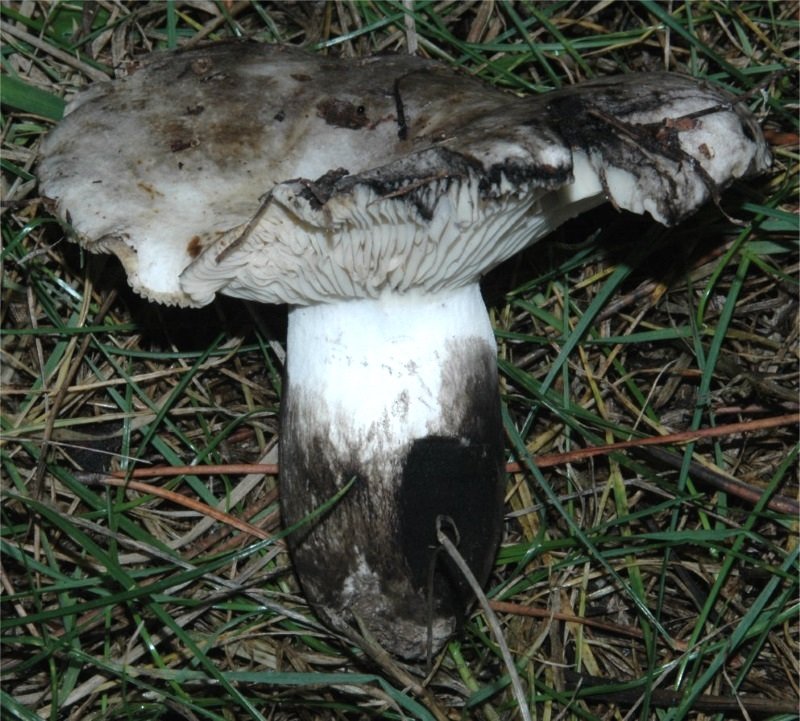
Podgruzdok white-black (Russula albonigra) - belongs to the genus russula, is included in the russula family. There are also such names of the mushroom: Podgruzdok black and white, Russula white and black, Chernushka white and black. The mushroom has an interesting minty pulp flavor.
The white and black podgruzdok has a hat with a diameter of seven to twelve centimeters. At first, the pulp is convex, but then it has a tucked edge. As the fungus develops, the cap flattens and becomes concave. The color of the cap also changes - from white with a dirty tint to brown, almost black. Has a matte surface, smooth. Usually it is dry, only in wet weather - sometimes sticky. Often, various forest debris can adhere to such a hat. The skin is easily removed from the cap.
The plates of such a mushroom are narrow and frequent. As a rule, they are of different lengths, often transitioning to a short stem. The color of the plates is first white or slightly creamy, and then they gradually turn black. Spore powder - white or light cream shade.
The white-black podgruzdok has a small leg - from three to seven centimeters. Its thickness is up to two and a half centimeters. It is smooth, dense, cylindrical in shape. As the mushroom matures, it gradually turns black.
This mushroom has a dense, hard stem. If the mushroom is young, then it is white, but then it becomes darker. The smell of the mushroom is weak, vague. But the taste is mild, has a slight mint note. Occasionally, specimens with a more pungent taste may come across.
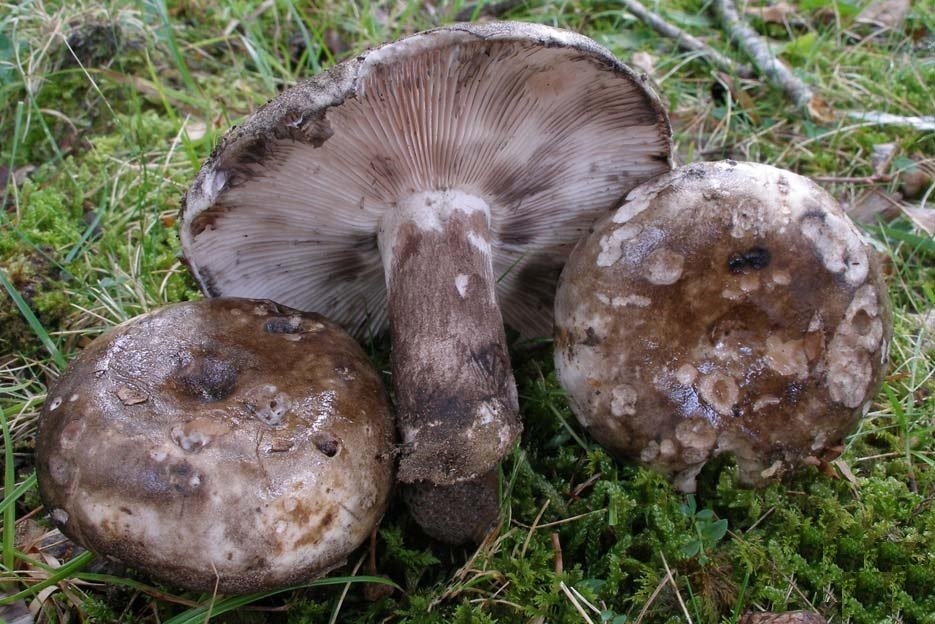
White-black podgruzdok grows in many forests - coniferous, broad-leaved. Growing time - from July to early October. But it is quite rare in the forests of Europe, Asia and North America.
It belongs to edible mushrooms, but its taste is rather mediocre. According to some Western researchers, it is still inedible or even poisonous. The fungus can cause gastrointestinal upset.
Similar species
- Blackening podgruzdok - Compared to white-black, this is a larger mushroom. He does not have such frequent plates, and the pulp turns red, and then turns black on the cut.
- Frequent podgruzdok (russula) - Quite often found in our forests. He has the same frequent plates, and the flesh on the cut also changes its color from light to dark and black. But the pulp of this mushroom has an unpleasant burning taste.
- Black russula - The pulp of this mushroom tastes good, and it also turns black when cut. The plates of this mushroom are frequent, dark in color.
Such mushrooms, together with a white-black load, are included in a special group of blackening mushrooms. This is due to the characteristic behavior of the flesh when cut, because it changes its color to black without going through the so-called brown stage. And if you act on the pulp of the mushroom with iron sulfate, then the color changes are completely different: at first it becomes pink, and then it acquires a green tint.
White-black russula (Russula albonigra)
or
Russula white-black

White-black russula (Russula albonigra) - belongs to the genus russula, is included in the russula family. There are also such names of the mushroom: Podgruzdok black and white, Russula white and black, Chernushka white and black. The mushroom has an interesting minty pulp flavor.
The black-and-white russula has a cap with a diameter of seven to twelve centimeters. At first, the pulp is convex, but then it has a tucked edge. As the fungus develops, the cap flattens and becomes concave. The color of the cap also changes - from white with a dirty tint to brown, almost black. Has a matte surface, smooth. Usually it is dry, only in wet weather - sometimes sticky. Often, various forest debris can adhere to such a hat. The skin is easily removed from the cap.
The plates of such a mushroom are narrow and frequent. As a rule, they are of different lengths, often transitioning to a short stem. The color of the plates is first white or slightly creamy, and then they gradually turn black. Spore powder - white or light cream shade.
The black-and-white russula has a small leg - from three to seven centimeters. Its thickness is up to two and a half centimeters. It is smooth, dense, cylindrical in shape. As the mushroom matures, it gradually turns black.
This mushroom has a dense, hard stem. If the mushroom is young, then it is white, but then it becomes darker. The smell of the mushroom is weak, vague. But the taste is mild, has a slight mint note. Occasionally, specimens with a more pungent taste may come across.

White-black russula grows in many forests - coniferous, broad-leaved. Growing time - from July to early October. But it is quite rare in the forests of Europe, Asia and North America.
It belongs to edible mushrooms, but its taste is rather mediocre. According to some Western researchers, it is still inedible or even poisonous. The fungus can cause gastrointestinal upset.
Similar species
- Blackening podgruzdok - Compared to white-black, this is a larger mushroom. He does not have such frequent plates, and the pulp turns red, and then turns black on the cut.
- Frequent podgruzdok (russula) - Quite often found in our forests. He has the same frequent plates, and the flesh on the cut also changes its color from light to dark and black. But the pulp of this mushroom has an unpleasant burning taste.
- Black russula - The pulp of this mushroom tastes good, and it also turns black when cut. The plates of this mushroom are frequent, dark in color.
Such mushrooms, together with a white-black load, are included in a special group of blackening mushrooms. This is due to the characteristic behavior of the flesh when cut, because it changes its color to black without going through the so-called brown stage. And if you act on the pulp of the mushroom with iron sulfate, then the color changes are completely different: at first it becomes pink, and then it acquires a green tint.
Frequent lamellar loading
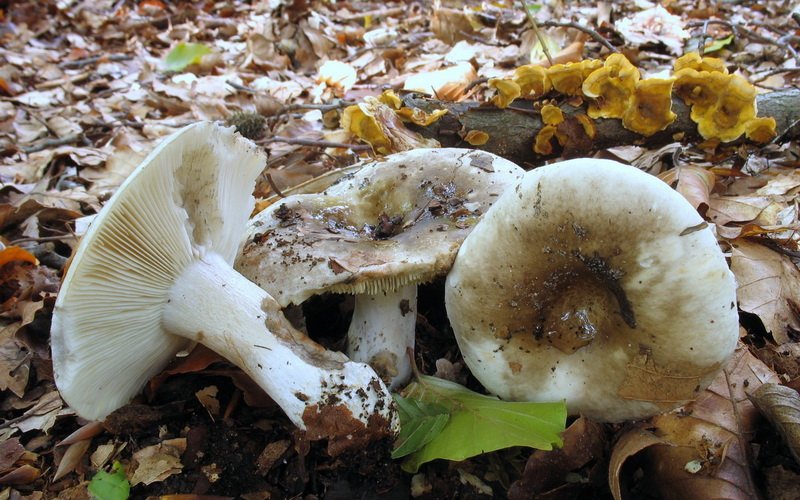
In the photo Frequent plate podgruzdok
Another name for this species is lamellar black. It is found more often in the south of Russia, in coniferous, mixed or deciduous forests.
The hat is distinguished by a more grayish, sometimes brownish tint, which, with the growth of the mushroom, becomes olive, and sometimes brown. Its diameter is rarely more than 12 cm. In young mushrooms, the cap is sticky, with age it becomes dry. The leg is the same shade as the cap.
The pulp on the break turns red, then brown, and then turns black. This lump has light plates that do not reach its legs.
The taste is inexpressive, the smell is weak.
In medicine, an extract from a lamellar load is used. It has antimicrobial activity. To relax muscles in medicine, it is the properties of this type of mushroom that are used.
In the kitchen, the podgruzdok is often fried, broths are made, marinated and salted. The mushroom does not need to be pre-cooked.
Blackening podgruzdok (Russula nigricans)
Russula blackening
Blackening podgruzdok - a type of mushroom included in the genus russula, belongs to the russula family.
It has a cap from 5 to 15 centimeters (sometimes larger specimens are found - even up to 25 centimeters in diameter). At first, the cap is whitish in color, but then it becomes dirty grayish, brown with a shade of soot color. There are also brownish specimens with an olive tint. The middle of the cap is darker and the edges are lighter. On the cap there are adhering particles of dirt, earth, forest debris.
The blackening podgruzdok has a smooth, dry cap (sometimes with a slight admixture of mucus). It is usually convex, but then becomes flat and spread. Its center becomes smooth over time. Cracks may form on the cap, which expose a beautiful white flesh.
The plates of the fungus are thick, large, and sparsely located. At first they are white, and then they turn gray or even brownish, with a pinkish tint. There are also atypical black plates.
Leg Loading blackening - up to 10 centimeters. It is strong, cylindrical in shape. As the fungus ages, it becomes a dirty brown color.
The pulp of the mushroom is thick, breaking. Usually white, slowly turns reddish at the site of the incision. It has a pleasant taste, slightly bitter, and a pleasant weak aroma. Ferrous sulfate turns this pulp pink (then it turns green).
Distribution area, growing time Blackening podgruzdok forms mycelium with hard tree species. Grows in deciduous, mixed forests. Also, the mushroom can often be seen in spruce and deciduous forests. A favorite place of distribution is the temperate zone, as well as the region of Western Siberia. The mushroom is not rare in Western Europe either.
In the forest, it is found in large groups. Begins to bear fruit in mid-summer, and this period ends until winter. According to the observations of mushroom pickers, it is found in such a northern region as the Karelian Isthmus, at the end of the forest it is not uncommon in the Leningrad region.
Mushroom twins
- Podgruzdok white and black (Russula albonigra). He has thick and falling plates, as well as a whitish hat, a grayish tint. The pulp of such a mushroom can turn black almost immediately. Redness is not visible in such mushrooms. In autumn, in birch and aspen forests, it is quite rare.
- Lamellar podgruzdok (Russula densifolia). It is distinguished by a brownish-brown and even brownish cap with a black tint. The plates of such a cap are very small, and the mushroom itself is smaller. The pulp first turns reddish, but then slowly turns black. In autumn, in coniferous and mixed forests, it is quite rare.
- The podgruzdok is black. When broken or cut, the flesh of this mushroom turns brown. But it has almost no dark, almost black shades. This mushroom is an inhabitant of coniferous forests.
These types of mushroom, as well as Podgruzdok blackening itself, form a separate group of mushrooms. They differ from others in that their flesh acquires a characteristic black color. Old mushrooms of this group are rather tough, and some of them can have both white and brown shades.
Is this mushroom edible? Blackening podgruzdok belongs to the fourth category of mushrooms. It can be eaten fresh (after boiling thoroughly for at least 20 minutes), as well as salted. In salty form, it quickly takes on a black tint. You need to collect only young mushrooms, since the old ones are quite tough. Moreover, they are almost always wormy. However, Western researchers consider this mushroom to be inedible.
Video about the blackening Podgruzdok mushroom:
Additional Information The fungus can grow in the substrate. Some old specimens of the fungus can come to the surface, this breaks the soil layer. The fungus can often be wormy. Another characteristic feature of the fungus is that it decomposes slowly in natural conditions. During decomposition, the mushroom turns black.Dried mushrooms persist for a long time, up to the next year.
Edible mushrooms and their types
There are a lot of edible mushrooms in nature - thousands of species. The most delicious are champignons, white, oyster mushrooms, mushrooms, boletus. To this list it is worth adding Caesar mushrooms, greenfinches, honey mushrooms, aspen mushrooms, boletus mushrooms, russula, umbrella mushrooms and others. Many of them are delicacies, such as the Caesar mushroom that grows on the Mediterranean coast.
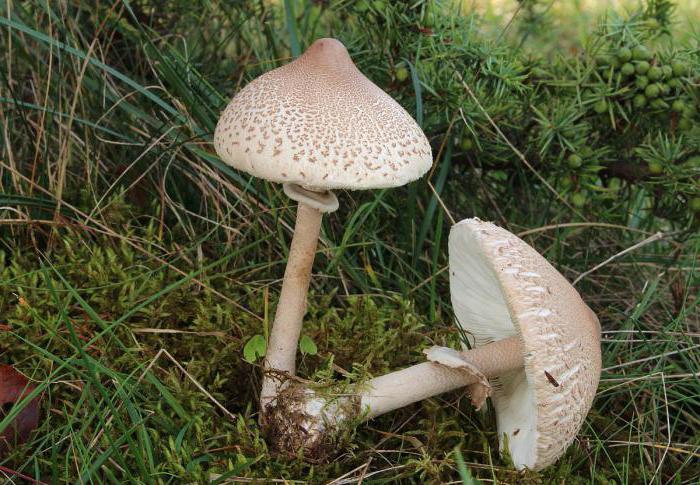
There are conventionally edible types of mushrooms. These include volushkas, milk mushrooms, valui mushroom, oak tree, bitter, morel, dung beetle and others. These gifts of the forest, after heat treatment, lose their poisonous properties inherent in their raw form. It is advisable to use young mushrooms for food, having previously boiled them in a large amount of water for at least 40 minutes. As a result of this treatment, all bitter and corrosive toxic substances are removed.
Edible mushrooms are a storehouse of nutrients. Next, let's talk about loading black - a bright representative of the russula family.
Similar species and how to distinguish from them
This load in the world of mushrooms has several doubles, or rather, representatives of this kingdom, very similar to it. It can be confused with a blackening load (Russula nigricans), from which the hero of the article differs in a darker hat and a moldy smell, as well as more frequent plates. If damaged, the flesh of the double does not turn red beforehand, but immediately turns black.
This mushroom can also be confused with the black-and-purple russula (Russula atropurpurea), which can sometimes acquire almost the same skin color as the black podgruzdock. It can be distinguished by the absence of a black spot in the middle of the cap, as well as by a less saturated color than that of a black-purple one.

